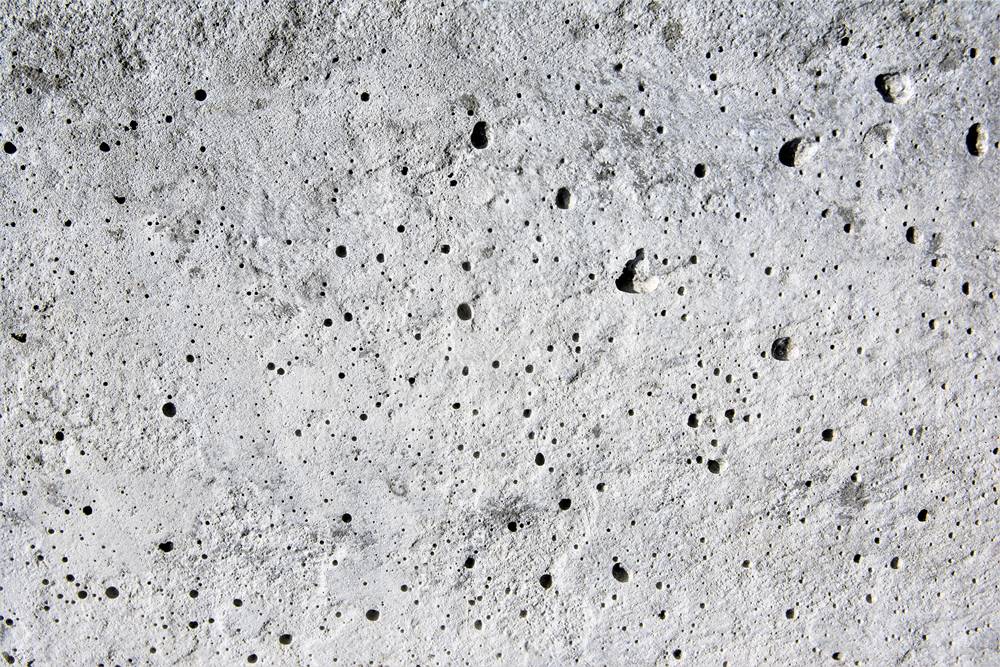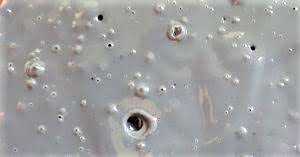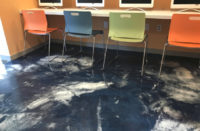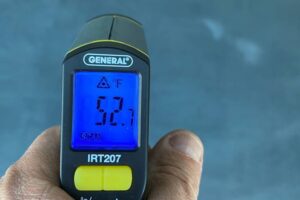
Although most perceive concrete as a dry dense substance, the inherently porous material more closely resembles a hard sponge. Microscopic voids and capillaries make up much of concrete’s matrix. As the material is poured and placed, these voids allow air and moisture to flow through it. This could lead to outgassing as the concrete cures.
Certain air voids or intentional air entrainment benefit concrete because they improve its freeze/thaw resistance. The entrained air allows room for internal water to freeze and expand, which aids in avoiding damage to the concrete.
While good for promoting concrete’s durability, air entrainment can also cause problems and outgassing defects. This can happen when you apply barrier coatings, such as epoxies and urethanes, to concrete surfaces.
What is outgassing?
Like most matter in nature, concrete seeks equilibrium with its surroundings. It releases air and water vapor that expands when temperatures increase. Alternatively, it absorbs air and moisture when temperatures decrease. We call the phenomenon of air expanding and releasing itself through the concrete pores “outgassing.”
As air moves in and out of concrete with changes in temperature and barometric pressure, the expanding air travels through the pores and capillaries, eventually reaching the surface. However, because the sponge-like concrete contains moisture, the expelled air coming to the surface often brings moisture with it. We call this moisture vapor transmission (MVT).
Primarily, a surface coating functions to provide a barrier that prevents water and chemical intrusion. However, when you apply a coating to an outgassing concrete surface, the air becomes trapped under the coating. Subsequently, the pressure of this trapped air causes a defect or pinhole in the liquid coating.
How can outgassing cause concrete defects?
Outgassing and pinholes can occur when an incompatible substance such as oil, soap, wax or dust contaminates a concrete surface. They can also occur when you don’t properly clean a surface before applying a coating.
Once the coating has cured, the pinhole often appears within a small bubble or crater on the surface. Sometimes a larger bump forms in a thicker, 100% solids coating. Defects in the coating film caused by outgassing can render the coating nonfunctional for its intended use.

Pinholes in coatings can also result from improper or insufficient material handling, mixing or a poor application method. These include over-rolling, mixing at a high speed or using an unsuitable blade. These practices can introduce excess air into liquid coatings, leading to pinholes as the air tries to escape after application.
Thinner coatings typically allow air to leave more efficiently, and often the coating film cures with a smooth finish. However, with thicker, 100% solids coating systems, pinholing is more noticeable since air bubbles have a harder time passing through. Nevertheless, you can control these application-based pinholes by using the right tools and methods to mix and apply concrete.
Although outgassing doesn’t always cause coating application problems, it can pose an issue as a result of poor environmental conditions and improper application methods.
Three ways to identify and prevent outgassing
You’ll rarely find outgassing defects across an entire coated-concrete surface. It’s more common to find them scattered seemingly at random. Defects can be clustered in areas directly exposed to sunlight or where mechanical surface preparation was more aggressive. They can even appear in areas with increased air circulation.
Other means and precautionary approaches to minimize outgassing defects include:
Monitoring environmental conditions
The primary method to reduce defects caused by concrete outgassing is to monitor environmental conditions before and during coating application. A continuous flow of air over a porous concrete slab could entice entrapped air to flow outward. This movement leads to outgassing and coating defects. Ensure that heating/cooling systems and open doors/windows don’t blow air across concrete surfaces during the coating application and curing process.
Track temperature changes
An increasing surface temperature strongly indicates that outgassing will occur. When weather fronts are on the horizon, it’s best to wait before coating. Hot concrete and/or rising ambient temperatures cause air to move within the slab at a more extreme rate.
Barometric pressure changes can also push air into concrete and repeatedly vacuum it out. When barometric pressure fluctuates, outgassing may occur even when all other conditions are ideal. Applying the coating in a consistently HVAC-controlled environment, or in the evening when the air temperature decreases, can reduce outgassing.
Sealing the concrete with a primer
To reduce outgassing, especially on porous or rough surfaces, seal the concrete after surface preparation with a low-viscosity, deep-penetrating primer. Because of their thin consistency, primers will less likely exhibit pinholes or other defects from outgassing. The air can make its way through the primer, which subsequently fills in spaces where the air escaped.
Primers soak into the concrete and fill voids and capillaries that can hold air, thereby reducing the chances of outgassing. Most primers tolerate moisture. And some are formulated to act as MVT reducers or oil blockers as well.
How to repair outgassing issues
Repairing outgassing issues requires recoating with the same material. Since most outgassing defects occur scattered around a project, reapplying only the affected areas will lead to an undesirable, patchy appearance. To correct outgassing defects both aesthetically and functionally, it may require recoating an entire floor or wall. This can be time consuming and costly.
To ultimately prevent outgassing, be aware of the conditions that lead to this predicament. Thoughtfully plan your coating installations and follow precautions. This can significantly reduce the possibility of outgassing and prevent the added expenses and frustration associated with resolving it.















